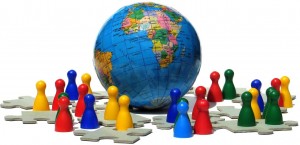The world in which we live in is made up of optimists and pessimists. There are those who always look for the bright side in a given situation and then there are those who just expect the worst. In terms of international relations, we call the optimists the liberals and constructivists and we call the pessimists the realists. Liberals believe that global cooperation can be achieved and is an alternative to power politics. Constructivists are a bit different. They believe that change in world politics can transpire without having to change the entire structure of the international system. Realists on the other hand think that everyone is in it for themselves. It is all a game of who can get the most power between sovereign states.
According to Russell Bova’s book “How the World Works”, “While liberals and constructivists see global problems like the environment pushing states toward cooperation and global solutions, U.S. nonparticipation in the Kyoto Protocol and the disappointing outcome at Copenhagen reinforce realist skepticism. Indeed, realists see those environmental problems as yet another potential source of international conflict” (p.248). Realists see that international conflicts will arise such as competition for scarce resources. Just like the power game, a race will start regarding who can get the most of what is running out—let’s face it, the bigger country with the most power will win.
If every single country decides to cooperate and solutions are created for our global problems, all might be well and go smoothly…NOT! This is where the question of governance for whom comes into play. Harriet Bulkeley and Peter Newell addressed this question pretty well in “Governing Climate Change.” They discussed three areas where issues arise regarding global problems. The questions of who is responsible, who pays for action on mitigation and adaption, and who bears the costs of actions and inactions pops up. The countries that have contributed the least amount of carbon emissions which would be the developing nations, are actually much more susceptible to the effects of climate change than the large actors. Richer countries have the ability to adapt to the impacts of climate change. For example, Bangladesh is a country that lies below sea level. When areas in Bangladesh are hit hard and homes, lands, family, as well as many other things are lost, who comes to their rescue? It’s certainly not their government because they cannot afford it. These people living in these areas have to fend for themselves and establish a whole new life in the slums of a city. They have to start from scratch. However, when the Northeastern coast was hit by hurricane Sandy, shelters, food, repairs, and so much more were provided to those who needed the aid. The government had funds to aid those in need and also had money to repair the damages. In New York City, the subways were drained, houses near beaches were fixed, and even places such as South Street Seaport were repaired almost immediately. A big and powerful country like the United States has the ability to go back to our daily routines. Countries like Bangladesh do not.
Climate change was caused by the development of the North. The United States has contributed twenty percent towards global emissions. The United States alone caused this much damage, so why should others pay the price? Ultimately, can all of the countries in the world cooperate and come up with global solutions when the United States did not even participate in the Kyoto Protocol?

